World War One Fronts
The reward of answering the call for army recruits was the horror of trench warfare with its rats, disease, mud, constant shelling and shooting and fear of imminent death.
The trenches systems were on every front of World War One.
A front is a stretch of land where warring countries confront each other and engage in battle. Trenches were widespread on the Western Front - a 400-plus mile stretch weaving through France and Belgium and down to the Swiss border.
This is where the majority of British and Irish soldiers fought in World War One. Though they also saw action in:
- Gallipoli (modern day Turkey)
- Mesopotamia (modern day Iraq)
- Africa
If you were a soldier on the front line, you would most likely be operating out of a trench.
Trenches became valuable to WW1 armies because they were a defensive solution to modern weaponry. Before the war, many people thought that the battles would consist of thousands of advancing in formation towards each other, like the ones they had read about from the previous century. The reality was very different.
Weapons for fighting
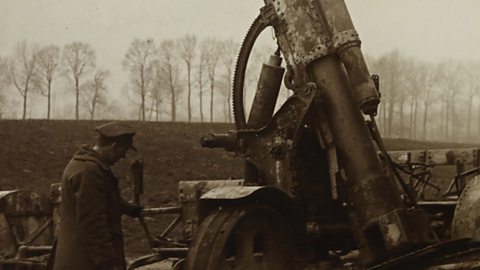
It had been over fifty years since the last war between the major powers. In that time armies had modernised and developed new war-fighting technologies. As a result, attacking soldiers faced unprecedented firepower.
Machine guns were now capable of firing hundreds of rounds per minute and a modern rifle could be repeatedly fired.
Furthermore, artillery - weapons for discharging missiles - were firing explosives and releasing shrapnel, shells that exploded in the air firing metal fragments towards the enemy.
As a result of all this new firepower, commanders were unable to use traditional military tactics without their battalions suffering enormous casualties.
Defence became the priority, the digging of trenches developed and they were employed for the duration of the war.

The trench network
Both the British and German armies used trench systems which they saw as a temporary measure. If you look at pictures of the earliest trenches, they were little more than simple ditches. Over time, the trenches developed into more complex systems.These systems had a common layout of three lines on the front:
- the front line - known as the fire trench
- the second line - known as the support trench
- the third line - known as reserve trench
Connecting these were the communications trenches, which allowed for easy movement between the three lines. The communications trenches allowed men to run up and down between the lines with material and supplies without having to go over open ground. Some of them were so intricate that they gave trenches street names, so that soldiers knew where they were going.
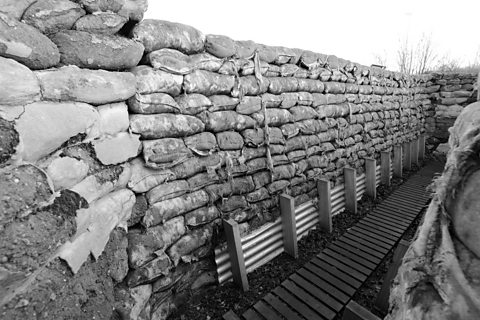
Illness
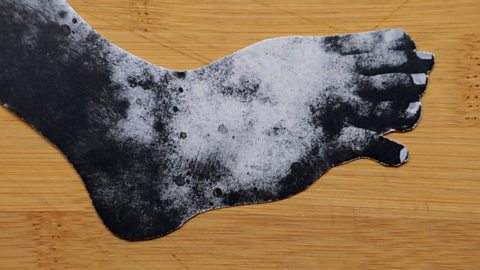
Soldiers in the trenches were confronted by a range of hardships and a variety of illnesses. Conditions varied depending on where you were fighting, what the weather was like and the time of year.
In 1914, the winter weather was particularly bad with enormous amounts of rain. Soldiers could find themselves standing in muddy water for days on end and this could lead to a condition known as Trench Foot.
Small cuts and blisters on the feet would become infected, leading to numbness, swelling and even gangrene. Many lost toes and in extreme cases had a foot amputated.
However, on other fronts, such as Gallipoli, it was flies rather than mud that caused issues. Soldiers lacked the protective clothing to avoid being bitten. The flies caused hygiene problems and several thousand soldiers died of dysentery.
Another common problem among the soldiers was lice. Due to poor hygiene, overcrowding and a lack of fresh clothing, many soldiers would find themselves infested. In some cases, the lice spread an infection known as ÔÇÿtrench feverÔÇÖ. One way of killing the lice was to ÔÇÿpopÔÇÖ them with the end of a cigarette.
Soldiers also shared the trenches with pests such as rats. They were attracted by the stores of food and rotting bodies. Many soldiers remarked on their size and the phrase ÔÇÿrats as big as catsÔÇÖ was often recorded in letters and diaries.

Rest
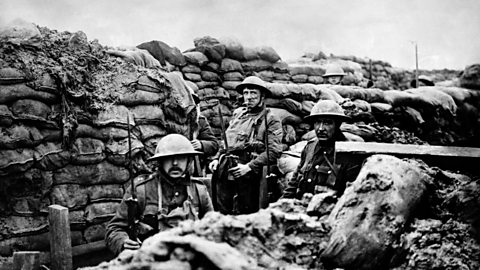
Most activity in front line trenches took place at night. Until dawn, soldiers were required to take their rifles and stand on watch as the early morning was a common time for the other side to attack.
During the daytime, soldiers in the front line trenches took turns on lookout so that others could take a rest in the dugouts. From small hollows to deep underground shelters, the places where you could rest varied according to your rank.
Apart from resting, soldiers used their free time to clean their riffles and write letters home. There were long periods without combat and boredom was an issue.
Obviously, soldiers did not feel safe in the trenches. Although the trenches were designed to minimise the number of casualties, they were still at risk of gun fire and shrapnel. Sometimes the shell fire caused trenches to collapse burying men beneath the clay.
Soldiers couldnÔÇÖt peek their heads above the trenches because of the snipersÔÇÖ bullets. Artillery could be fired randomly into the opposition trench, killing an unsuspecting soldier.
The random nature of death took a heavy toll on the mental health of the soldiers as it was a constant fear. Many suffered trauma through what they experienced.
Doctors at the time understood much less about mental health than they do today. They mistakenly thought that the psychological damage was a result of constant exposure to loud shellfire and named the condition ÔÇÿshell shockÔÇÖ.
No ManÔÇÖs Land

The areas between the opposing forces at the Western Front was known as No ManÔÇÖs Land. It was in these areas that the bulk of the actual fighting took place. Although the boundaries were unofficial and often changed, many were defined by coils of barbed wire and the position of the front lines on either side. Soldiers would receive the order to ÔÇÿgo over the topÔÇÖ and climb out in formation into No ManÔÇÖs Land to advance toward the enemy trench. Many were immediately brought down by machine gun fire.

Zone Rouge
Even today, more than 100 years later there are reminders of No ManÔÇÖs Land. Zone Rouge in France, for example, is littered with unexploded shells and bombs from WW1. Because of this, and the deadly chemicals the land still contains, the government forbids entry to unauthorised people to much of this area, Many believe that Zone Rouge will never be fully cleared - the French government estimates it will take another 300 years to clear the whole battlefield.

Test yourself
More on World War One
Find out more by working through a topic
- count1 of 5
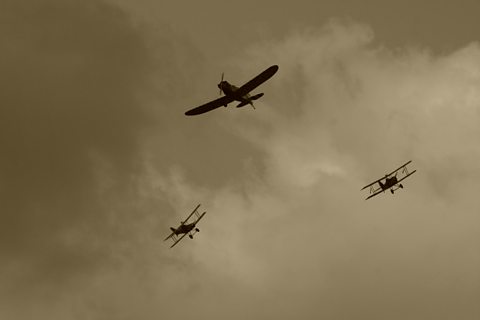
- count2 of 5
